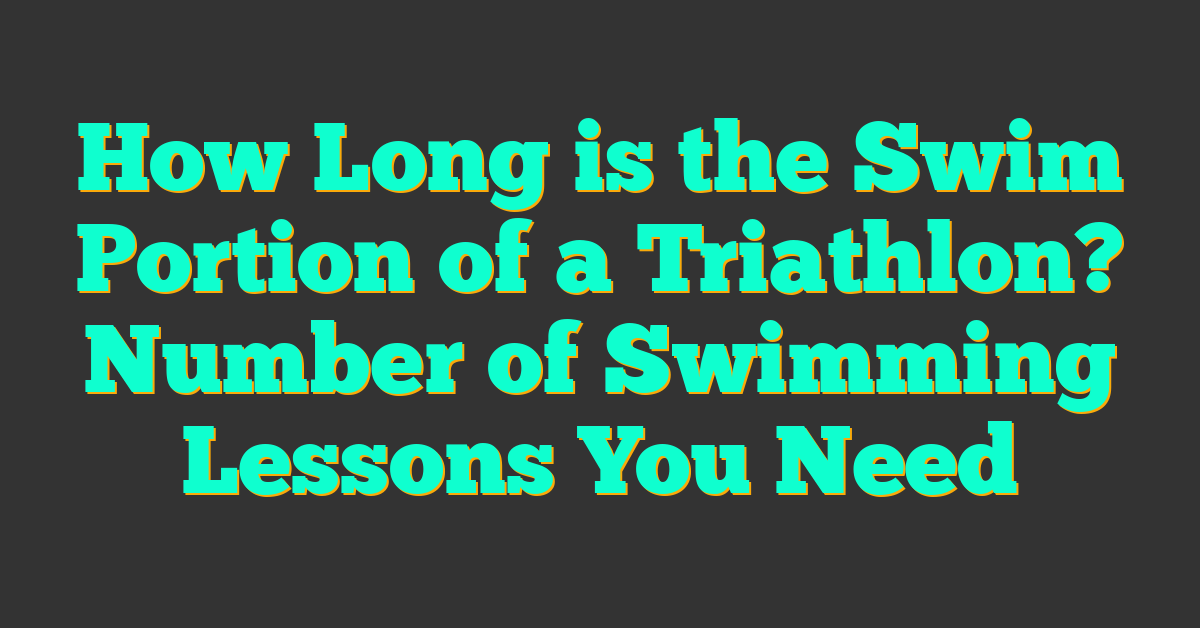If you’re considering participating in a triathlon, you may be wondering how long the swim portion of the race is and how many swimming lessons you need to prepare. The swim leg of a triathlon is typically the shortest part of the race, but the distance varies depending on the type of triathlon you’re competing in. Understanding the distances and preparing accordingly can help you feel confident and ready on race day.

In general, a sprint triathlon swim is around 750 meters, while an Olympic triathlon swim is approximately 1.5 kilometers. A half-Ironman swim is 1.9 kilometers, and a full Ironman swim is 3.8 kilometers. These distances may seem daunting, but with proper training and preparation, you can swim these distances with ease. In the next sections, we’ll discuss how to prepare for the swim leg of a triathlon, including how many swimming lessons you may need, and how to develop a triathlon swim training plan.
Key Takeaways
- The swim portion of a triathlon varies in length depending on the race distance, with sprints being the shortest and full Ironman races being the longest.
- Preparing for the swim leg of a triathlon involves not only physical training but also developing a strategy for race day.
- Swimming lessons can be helpful for beginners, but even experienced swimmers can benefit from refining their technique and improving their endurance.
Understanding Triathlon Swim Distances
https://www.youtube.com/watch?v=mJPjwvGr5v8&embed=true

If you’re new to triathlons, you might be wondering about the swim portion of the race and how long it is. The swim distance can vary depending on the type of triathlon you’re participating in, so it’s important to understand the differences between each category.
Triathlon Categories and Swim Distances
There are several categories of triathlons, each with its own swim distance. The most common categories are:
- Super Sprint: 400m swim
- Sprint: 750m swim
- Olympic: 1.5km swim
- Half Ironman: 1.9km swim
- Ironman: 3.8km swim
As you can see, the swim distance increases as the race distance increases. The Super Sprint and Sprint categories are great for beginners, while the Olympic, Half Ironman, and Ironman categories are better suited for more experienced triathletes.
Differences Between Pool and Open Water Swimming
It’s important to note that there are differences between swimming in a pool and swimming in open water. Pool swimming is usually more controlled and predictable, while open water swimming can be more challenging due to factors such as currents, waves, and visibility.
If you’re new to open water swimming, it’s a good idea to practice in a pool first and gradually work your way up to open water. You should also consider taking swimming lessons to improve your technique and endurance.
In summary, the swim portion of a triathlon can vary depending on the category of the race. It’s important to understand the differences between each category and to practice swimming in both pools and open water to prepare for race day.
Preparing for the Swim Leg of a Triathlon
https://www.youtube.com/watch?v=Zh9bhXe5lug&embed=true
If you’re new to triathlon, the swim leg can be the most intimidating part of the race. However, with the right preparation, you can approach it with confidence. In this section, we’ll cover the essential gear you need and how to master the right technique and form.
Essential Gear for Triathlon Swimming
Before you start training, you’ll need to invest in some essential gear for triathlon swimming. Here are the items you should consider:
- Swimsuit: Choose a swimsuit that is comfortable and fits well. A tight-fitting suit will reduce drag and improve your speed in the water.
- Goggles: Goggles protect your eyes and help you see underwater. Choose a pair that fits well and doesn’t leak.
- Swim cap: A swim cap reduces drag and keeps your hair out of your face. Choose a silicone or latex cap that fits snugly.
- Wetsuit: A wetsuit provides buoyancy and insulation in cold water. Choose a wetsuit that fits well and allows for full range of motion.
- Buoy: A buoy is a flotation device that attaches to your waist and helps you stay afloat. It’s especially useful for open water swimming.
- Pull buoy: A pull buoy is a flotation device that goes between your legs and helps you focus on your upper body technique.
- Fins: Fins provide extra propulsion and help you work on your kick technique.
- Paddles: Paddles increase resistance and help you build upper body strength.
- Snorkel: A snorkel allows you to focus on your technique without worrying about breathing.
Mastering the Right Technique and Form
Once you have your gear, it’s time to focus on technique and form. Here are some tips to keep in mind:
- Stroke: The most efficient stroke for triathlon swimming is the freestyle or front crawl. Focus on a high elbow catch and a strong pull.
- Kick: A strong kick is important for balance and propulsion. Use a flutter kick and keep your legs close together.
- Body position: Keep your body horizontal and close to the surface of the water. This will reduce drag and improve your speed.
- Breathing technique: Practice breathing on both sides and exhaling fully underwater. This will help you stay relaxed and conserve energy.
By following these tips and investing in the right gear, you’ll be well on your way to mastering the swim leg of a triathlon. Remember to start slowly and build up your endurance over time. With practice and dedication, you’ll be able to complete the swim portion of a triathlon with ease.
Swimming Lessons: How Many and What Kind?

If you’re new to triathlons, you might be wondering how many swimming lessons you need to take before you’re ready to tackle the swim portion of a race. The answer depends on your current swimming ability and the specific race distance you’re training for.
Determining the Number of Lessons Needed
If you’re a beginner swimmer, it’s recommended that you take at least 10 to 12 swimming lessons before attempting a triathlon. During these lessons, you’ll learn the basics of freestyle and breaststroke, as well as important technique and training tips.
If you’re an intermediate swimmer, you may only need a few lessons to brush up on your technique and learn some new drills. A coach can help you identify areas for improvement and create a training plan that includes warm-up sets, speed work, and main sets with intervals.
Types of Strokes and Drills in Swim Training
In swim training, you’ll focus on two main strokes: freestyle and breaststroke. Freestyle is the fastest and most efficient stroke for triathlon swimming, while breaststroke is a good option for beginners or those who need to conserve energy.
During your swimming lessons, you’ll also learn a variety of drills to improve your technique and build strength. Some common drills include:
- Kickboard drills: These drills focus on improving your kick and body position in the water.
- Pull buoy drills: These drills help you develop upper body strength and improve your pull technique.
- Catch-up drills: These drills help you improve your freestyle technique by focusing on your arm position and timing.
By incorporating a variety of strokes and drills into your training, you can improve your overall swimming ability and prepare for the swim portion of a triathlon.
Developing a Triathlon Swim Training Plan
« How Long is an Olympic Triathlon? A Guide to the Distances You’ll Cover
How Long Should a Wetsuit Last? A Friendly Guide to Wetsuit Longevity »
https://www.youtube.com/watch?v=oM4sHl1hTEE&embed=true
If you are new to triathlon, you may be wondering how to develop a training plan that will prepare you for the swim portion of the race. The good news is that with the right plan, you can build both endurance and speed in the water, and feel confident and comfortable on race day. In this guide, we’ll show you how to build a swim training plan that works for you.
Building Endurance and Speed
To build endurance and speed in the water, you’ll need to incorporate both aerobic and anaerobic training into your swim workouts. Aerobic training involves swimming at a steady pace for an extended period of time, while anaerobic training involves shorter, more intense bursts of speed.
To build endurance, start with shorter swims and gradually increase the distance over time. For example, you might start with a 500-meter swim and gradually work your way up to 1500 meters. To build speed, incorporate interval training into your workouts. For example, you might swim 50 meters at a fast pace, followed by 50 meters at a slower pace, and repeat this pattern for several laps.
Incorporating Rest and Recovery
Rest and recovery are just as important as training when it comes to building endurance and speed in the water. Make sure to include rest days in your training plan, and take the time to stretch and foam roll after each workout to help prevent injury and reduce muscle soreness.
In addition to rest days, you can also incorporate active recovery into your training plan. Active recovery involves low-intensity exercises that help to increase blood flow and promote muscle recovery. For example, you might do some light swimming or take a yoga class on your rest days.
By following these tips and building a training plan that works for you, you can become a confident and comfortable swimmer, and be ready to tackle the swim portion of your next triathlon. Remember to consult with experts in the triathlon community and listen to your body as you build your training plan.
Race Day Strategies and Tips
https://www.youtube.com/watch?v=uWsuu2TZdig&embed=true
Navigating Transitions and Maintaining Focus
On race day, you will need to navigate transitions between the swim, bike ride, and run. It is important to maintain focus and stay calm during these transitions. You can practice transitions during your training to help you become more comfortable with them. Make sure to have all of your gear organized and easily accessible. You can use a checklist to ensure that you have everything you need.
During the transitions, it is important to keep your core engaged to maintain good posture and balance. This will help you to transition smoothly and efficiently. You can also practice visualization techniques to help you stay focused and calm during the transitions.
Adapting to Race Conditions and Competition
When it comes to racing, it is important to be adaptable and flexible. You will need to adapt to the race conditions and the competition. For example, if it is a windy day, you may need to adjust your bike ride strategy. You may also need to adjust your strategy based on the competition.
If you are racing in a triathlon event, make sure to familiarize yourself with the different categories and rules. You should also be aware of drafting and sighting techniques. If you are racing in a duathlon, make sure to practice your transitions between the run and bike ride.
Before the race, make sure to warm-up properly. You can use the 10/10/10 method to warm up: 10 minutes of easy running, 10 minutes of biking, and 10 minutes of swimming. Swimming should be last, so you don’t have to change again before you line up.
Finally, access your potential and set realistic goals for the race. Don’t make exaggerated or false claims. Have a plan in place, but be flexible and adaptable. Remember to enjoy the experience and have fun!
Frequently Asked Questions
https://www.youtube.com/watch?v=13Bjb2dsPxk&embed=true
What is the typical distance for the swim portion in a sprint triathlon?
The swim portion for a sprint triathlon typically ranges from 400 to 750 meters (0.25 to 0.5 miles), depending on the race’s location and the organizer. You can expect to complete the swim in around 15 minutes if you’re an average triathlete.
How many weeks should I train for the swim section of an Olympic triathlon?
For the swim section of an Olympic triathlon, it’s recommended that you train for at least 12 weeks, with three swim sessions per week to build endurance and improve your technique.
What’s the average number of swim sessions recommended per week during Ironman training?
During Ironman training, it’s recommended that you swim at least three times per week, with each session lasting between 45 minutes to an hour and a half. The total distance covered per week should be around 7,000 to 10,000 meters (7 to 10 kilometers or 4.3 to 6.2 miles).
How many meters or yards are involved in the swimming leg of different triathlon distances?
In a Sprint triathlon, the swim distance is usually around 750 meters (0.47 miles) or less. In an Olympic triathlon, the swim leg is 1.5 kilometers (0.93 miles), while in a Half-Ironman, it’s 1.9 kilometers (1.2 miles). Finally, in a Full Ironman, the swim distance is 3.8 kilometers (2.4 miles).
Can you suggest a good training plan for a beginner in triathlon swimming?
For beginners, it’s recommended to start with basic swim lessons to learn the proper technique and build endurance. After that, you can start with a beginner’s triathlon training plan that includes three swim sessions per week, gradually increasing the distance and intensity over time. It’s important to focus on technique and endurance rather than speed in the beginning.
What are some effective ways to improve my swim times for a triathlon?
There are several ways to improve your swim times for a triathlon. First, focus on your technique and form, as this will help you swim more efficiently. Second, practice open water swimming, as this is different from swimming in a pool and will help you get used to the conditions of a triathlon. Third, incorporate interval training into your swim sessions to improve your speed and endurance. Finally, consider working with a coach or joining a swim club to get feedback and support.





![Lamicall Bike Frame Bag Waterproof - [1s Release] [2 in](https://m.media-amazon.com/images/I/41WyOmmNsYL._SL500_.jpg)




